-
TAS5760LD General-Purpose I2S Input Class-D Amplifier With DirectPath™ Headphone and Line Driver
- 1 Features
- 2 Applications
- 3 Description
- 4 Revision History
- 5 Pin Configuration and Functions
-
6 Specifications
- 6.1 Absolute Maximum Ratings
- 6.2 ESD Ratings
- 6.3 Recommended Operating Conditions
- 6.4 Thermal Information
- 6.5 Digital I/O Pins
- 6.6 Master Clock
- 6.7 Serial Audio Port
- 6.8 Protection Circuitry
- 6.9 Speaker Amplifier in All Modes
- 6.10 Speaker Amplifier in Stereo Bridge-Tied Load (BTL) Mode
- 6.11 Speaker Amplifier in Mono Parallel Bridge-Tied Load (PBTL) Mode
- 6.12 Headphone Amplifier and Line Driver
- 6.13 I²C Control Port
- 6.14 Typical Idle, Mute, Shutdown, Operational Power Consumption
- 6.15 Typical Speaker Amplifier Performance Characteristics (Stereo BTL Mode)
- 6.16 Typical Performance Characteristics (Mono PBTL Mode)
- 7 Parameter Measurement Information
-
8 Detailed Description
- 8.1 Overview
- 8.2 Functional Block Diagram
- 8.3 Feature Description
- 8.4
Device Functional Modes
- 8.4.1
Hardware Control Mode
- 8.4.1.1 Speaker Amplifier Shut Down (SPK_SD Pin)
- 8.4.1.2 Serial Audio Port in Hardware Control Mode
- 8.4.1.3 Soft Clipper Control (SFT_CLIP Pin)
- 8.4.1.4 Speaker Amplifier Switching Frequency Select (FREQ/SDA Pin)
- 8.4.1.5 Parallel Bridge Tied Load Mode Select (PBTL/SCL Pin)
- 8.4.1.6 Speaker Amplifier Sleep Enable (SPK_SLEEP/ADR Pin)
- 8.4.1.7 Speaker Amplifier Gain Select (SPK_GAIN [1:0] Pins)
- 8.4.1.8 Considerations for Setting the Speaker Amplifier Gain Structure
- 8.4.2 Software Control Mode
- 8.4.1
Hardware Control Mode
- 8.5
Register Maps
- 8.5.1 Control Port Registers - Quick Reference
- 8.5.2
Control Port Registers - Detailed Description
- 8.5.2.1 Device Identification Register (0x00)
- 8.5.2.2 Power Control Register (0x01)
- 8.5.2.3 Digital Control Register (0x02)
- 8.5.2.4 Volume Control Configuration Register (0x03)
- 8.5.2.5 Left Channel Volume Control Register (0x04)
- 8.5.2.6 Right Channel Volume Control Register (0x05)
- 8.5.2.7 Analog Control Register (0x06)
- 8.5.2.8 Reserved Register (0x07)
- 8.5.2.9 Fault Configuration and Error Status Register (0x08)
- 8.5.2.10 Reserved Controls (9 / 0x09) - (15 / 0x0F)
- 8.5.2.11 Digital Clipper Control 2 Register (0x10)
- 8.5.2.12 Digital Clipper Control 1 Register (0x11)
-
9 Application and Implementation
- 9.1 Application Information
- 9.2
Typical Applications
- 9.2.1
Stereo BTL Using Software Control
- 9.2.1.1 Design Requirements
- 9.2.1.2
Detailed Design Procedure
- 9.2.1.2.1 Startup Procedures- Software Control Mode
- 9.2.1.2.2 Shutdown Procedures- Software Control Mode
- 9.2.1.2.3 Component Selection and Hardware Connections
- 9.2.1.2.4 Recommended Startup and Shutdown Procedures
- 9.2.1.2.5
Headphone and Line Driver Amplifier
- 9.2.1.2.5.1 Charge-Pump Flying Capacitor and DR_VSS Capacitor
- 9.2.1.2.5.2 Decoupling Capacitors
- 9.2.1.2.5.3 Gain-Setting Resistor Ranges
- 9.2.1.2.5.4 Using the Line Driver Amplifier in the TAS5760LD as a Second-Order Filter
- 9.2.1.2.5.5 External Undervoltage Detection
- 9.2.1.2.5.6 Input-Blocking Capacitors
- 9.2.1.2.6 Gain-Setting Resistors
- 9.2.1.3 Application Curves
- 9.2.2 Stereo BTL Using Hardware Control
- 9.2.3 Mono PBTL Using Software Control
- 9.2.4 Mono PBTL Using Hardware Control
- 9.2.1
Stereo BTL Using Software Control
- 10Power Supply Recommendations
- 11Layout
- 12Device and Documentation Support
- 13Mechanical, Packaging, and Orderable Information
- IMPORTANT NOTICE
Package Options
Mechanical Data (Package|Pins)
- DCA|48
Thermal pad, mechanical data (Package|Pins)
- DCA|48
Orderable Information
TAS5760LD General-Purpose I2S Input Class-D Amplifier With DirectPath™ Headphone and Line Driver
1 Features
- Audio I/O Configuration:
- General Operational Features:
- Selectable Hardware or Software Control
- Integrated Digital Output Clipper
- Programmable I²C Address (1101100[R/W] or 1101101[R/W])
- Closed-Loop Amplifier Architecture
- Adjustable Switching Frequency for Speaker Amplifier
-
Robustness Features:
- Clock Error, DC, and Short-Circuit Protection
- Overtemperature and Programmable Overcurrent Protection
- Audio Performance (PVDD = 12 V, RSPK = 8 Ω, SPK_GAIN[1:0] Pins = 01)
2 Applications
- LCD/LED TV and Multipurpose Monitors
- Sound Bars, Docking Stations, PC Audio
- General-Purpose Audio Equipment
3 Description
The TAS5760LD is a stereo I2S input device which includes hardware and software (I²C) control modes, integrated digital clipper, several gain options, and a wide power supply operating range to enable use in a multitude of applications. The TAS5760LD operates with a nominal supply voltage from 4.5 to 15 VDC. The device has an integrated DirectPath™ headphone amplifier and line driver to increase system level integration and reduce total solution costs.
An optimal mix of thermal performance and device cost is provided in the 120-mΩ RDS(ON) of the output MOSFETs. Additionally, a thermally enhanced 48-Pin TSSOP provides excellent operation in the elevated ambient temperatures found in modern consumer electronic devices.
The entire TAS5760xx family is pin-to-pin compatible in the 48-Pin TSSOP package. Alternatively, to achieve the smallest possible solutions size for applications where pin-to-pin compatibility and a headphone or line driver are not required, a 32-Pin TSSOP package is offered for the TAS5760M and TAS5760L devices. The I2C register map in all of the TAS5760xx devices are identical, to ensure low development overhead when choosing between devices based upon system-level requirements.
Device Information(1)
| PART NUMBER | PACKAGE | BODY SIZE (NOM) |
|---|---|---|
| TAS5760LD | HTSSOP (48) | 12.50 mm × 6.10 mm |
- For all available packages, see the orderable addendum at the end of the datasheet.
Functional Block Diagram
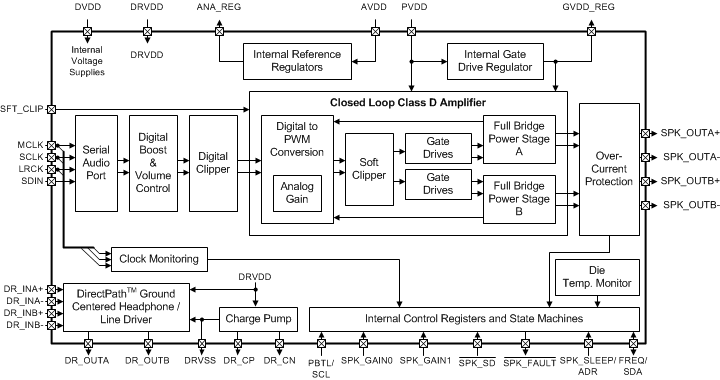
Output Power vs PVDD
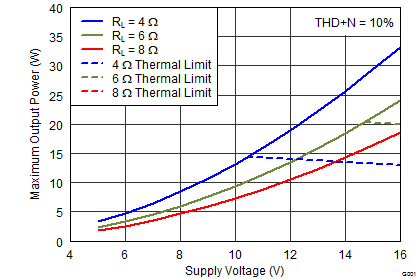
NOTE:
Thermal Limits were determined via the TAS5760xxEVM4 Revision History
Changes from B Revision (May 2017) to C Revision
Changes from A Revision (July 2015) to B Revision
- Changed Features list item, Audio Performance From: RLOAD = 8Ω To: RSPK = 8ΩGo
- Changed From: Voltage at speaker amplifier output pins To: Speaker Amplifier Output Voltage in the Abs Max tableGo
- Changed the Soft Clipper Control (SFT_CLIP Pin) sectionGo
- Updated the Register Map section to the new format. No new data addedGo
- Deleted statement of 64-kHz sample rate Go
- Changed Figure 58 device number reference From: TAS5760MD to TAS5760xDGo
- Changed paragraph text following Figure 58 From: This is the architecture of the TAS5760LD. To: This is the architecture of the headphone / line driver inside of the TAS5760LD.Go
Changes from * Revision (July 2013) to A Revision
- Added Pin Configuration and Functions section, ESD Ratings table, Feature Description section, Device Functional Modes, Application and Implementation section, Power Supply Recommendations section, Layout section, Device and Documentation Support section, and Mechanical, Packaging, and Orderable Information section Go
- Modified Master clock and Serial Audio Port specifications to reflect the clocking improvements of the device. Go
5 Pin Configuration and Functions
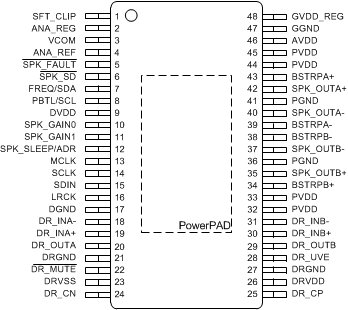
Pin Functions
6 Specifications
6.1 Absolute Maximum Ratings
over operating free-air temperature range (unless otherwise noted)(1)6.2 ESD Ratings
| VALUE | UNIT | |||
|---|---|---|---|---|
| V(ESD) | Electrostatic discharge | Human body model (HBM), per ANSI/ESDA/JEDEC JS-001(1) | 4000 | V |
| Charged-device model (CDM), per JEDEC specification JESD22-C101(2) | 1500 | |||
6.3 Recommended Operating Conditions
over operating free-air temperature range (unless otherwise noted)| MIN | NOM | MAX | UNIT | ||
|---|---|---|---|---|---|
| TA | Ambient Operating Temperature | –25 | 85 | °C | |
| AVDD | AVDD Supply | 4.5 | 16.5 | V | |
| PVDD | PVDD Supply | 4.5 | 16.5 | V | |
| DRVDD, DVDD | DRVDD and DVDD Supply | 2.8 | 3.63 | V | |
| VIH(DR) | Input Logic HIGH for DVDD and DRVDD Referenced Digital Inputs | DVDD | V | ||
| VIL(DR) | Input Logic LOW for DVDD and DRVDD Referenced Digital Inputs | 0 | V | ||
| RHP | Headphone Load | 16 | Ω | ||
| RLD | Line Driver Load | 1 | Ω | ||
| RSPK (BTL) | Minimum Speaker Load in BTL Mode | 4 | Ω | ||
| RSPK (PBTL) | Minimum Speaker Load in PBTL Mode | 2 | Ω | ||
6.4 Thermal Information
| THERMAL METRIC(1) | TAS5760LD | UNIT | ||
|---|---|---|---|---|
| DCA [HTSSOP] | DCA [HTSSOP] | |||
| 48 PIN(2) | 48 PIN(3) | |||
| θJA | Junction-to-ambient thermal resistance | 60.3 | 30.2 | °C/W |
| θJC(top) | Junction-to-case (top) thermal resistance | 16 | 14.3 | °C/W |
| θJB | Junction-to-board thermal resistance | 12 | 12.7 | °C/W |
| ψJT | Junction-to-top characterization parameter | 0.4 | 0.6 | °C/W |
| ψJB | Junction-to-board characterization parameter | 11.9 | 12.7 | °C/W |
| θJC(bottom) | Junction-to-case (bottom) thermal resistance | 0.8 | 0.7 | °C/W |
6.5 Digital I/O Pins
over operating free-air temperature range (unless otherwise noted)6.6 Master Clock
over operating free-air temperature range (unless otherwise noted)6.7 Serial Audio Port
over operating free-air temperature range (unless otherwise noted)| PARAMETER | TEST CONDITIONS | MIN | TYP | MAX | UNIT | |
|---|---|---|---|---|---|---|
| DSCLK | Allowable SCLK Duty Cycle | 45% | 50% | 55% | ||
| tH_L | Time high and low, SCLK, LRCK, SDIN | 10 | ns | |||
| tSU
tHLD |
Setup and Hold time. LRCK, SDIN input to SCLK edge | Input tRISE ≤ 1 ns, input tFALL ≤ 1 ns | 5 | ns | ||
| Input tRISE ≤ 4 ns, input tFALL ≤ 4 ns | 8 | |||||
| Input tRISE ≤ 8 ns, input tFALL ≤ 8 ns | 12 | |||||
| tRISE | Rise-time SCLK, LRCK, SDIN inputs | 8 | ns | |||
| tFALL | Fall-time SCLK, LRCK, SDIN inputs | 8 | ns | |||
| fS | Supported Input Sample Rates | Sample rates above 48kHz supported by "double speed mode," which is activated through the I²C control port | 32 | 96 | kHz | |
| fSCLK | Supported SCLK Frequencies | Values include: 32, 48, 64 | 32 | 64 | fS | |
6.8 Protection Circuitry
over operating free-air temperature range (unless otherwise noted)| PARAMETER | TEST CONDITIONS | MIN | TYP | MAX | UNIT | |
|---|---|---|---|---|---|---|
| OVERTHRES(PVDD) | PVDD Overvoltage Error Threshold | PVDD Rising | 18 | V | ||
| OVEFTHRES(PVDD) | PVDD Overvoltage Error Threshold | PVDD Falling | 17.3 | V | ||
| UVEFTHRES(PVDD) | PVDD Undervoltage Error (UVE) Threshold | PVDD Falling | 3.95 | V | ||
| UVERTHRES(PVDD) | PVDD UVE Threshold (PVDD Rising) | PVDD Rising | 4.15 | V | ||
| OTETHRES | Overtemperature Error (OTE) Threshold | 150 | °C | |||
| OTEHYST | Overtemperature Error (OTE) Hysteresis | 15 | °C | |||
| OCETHRES | Overcurrent Error (OCE) Threshold for each BTL Output | PVDD= 15V, TA = 25 °C | 7 | A | ||
| DCETHRES | DC Error (DCE) Threshold | PVDD= 12V, TA = 25 °C | 2.6 | V | ||
| TSPK_FAULT | Speaker Amplifier Fault Time Out period | DC Detect Error | 650 | ms | ||
| OTE or OCP Fault | 1.3 | s | ||||
| UVETHRES(DRVDD) | Undervoltage Error (UVE) Threshold for headphone and line driver amplifier | Sensed on DR_UVE pin | 1.25 | V | ||
| ILIMIT(DR) | Current Sourcing Limit of the Headphone and line driver amplifier | 68 | mA | |||
6.9 Speaker Amplifier in All Modes
over operating free-air temperature range (unless otherwise noted)| PARAMETER | TEST CONDITIONS | MIN | TYP | MAX | UNIT | |
|---|---|---|---|---|---|---|
| AV00 | Speaker Amplifier Gain with SPK_GAIN[1:0] Pins = 00 | Hardware Control Mode (Additional gain settings available in Software Control Mode)(1) | 25.2 | dBV | ||
| AV01 | Speaker Amplifier Gain with SPK_GAIN[1:0] Pins = 01 | Hardware Control Mode (Additional gain settings available in Software Control Mode)(1) | 28.6 | dBV | ||
| AV10 | Speaker Amplifier Gain with SPK_GAIN[1:0] Pins = 10 | Hardware Control Mode (Additional gain settings available in Software Control Mode)(1) | 31 | dBV | ||
| AV11 | Speaker Amplifier Gain with SPK_GAIN[1:0] Pins = 11 | (This setting places the device in Software Control Mode) | (Set via I²C) | |||
| |VOS|(SPK_AMP) | Speaker Amplifier DC Offset | BTL, Worst case over voltage, gain settings | 10 | mV | ||
| PBTL, Worst case over voltage, gain settings | 15 | mV | ||||
| fSPK_AMP(0) | Speaker Amplifier Switching Frequency when PWM_FREQ Pin = 0 | (Hardware Control Mode. Additional switching rates available in Software Control Mode.) | 16 | fS | ||
| fSPK_AMP(1) | Speaker Amplifier Switching Frequency when PWM_FREQ Pin = 1 | (Hardware Control Mode. Additional switching rates available in Software Control Mode.) | 8 | fS | ||
| RDS(ON) | On Resistance of Output MOSFET (both high-side and low-side) | PVDD = 15 V, TA = 25 °C, Die Only | 120 | mΩ | ||
| PVDD= 15V, TA = 25 °C, Includes: Die, Bond Wires, Leadframe | 150 | mΩ | ||||
| fC | –3-dB Corner Frequency of High-Pass Filter | fS = 44.1 kHz | 3.7 | Hz | ||
| fS = 48 kHz | 4 | |||||
| fS = 88.2 kHz | 7.4 | |||||
| fS = 96 kHz | 8 | |||||
6.10 Speaker Amplifier in Stereo Bridge-Tied Load (BTL) Mode
input signal is 1 kHz Sine, specifications are over operating free-air temperature range (unless otherwise noted)| PARAMETER | TEST CONDITIONS | MIN | TYP | MAX | UNIT | |
|---|---|---|---|---|---|---|
| ICN(SPK) | Idle Channel Noise | PVDD = 12 V, SPK_GAIN[1:0] Pins = 00, RSPK = 8Ω, A-Weighted |
- | 66 | - | µVrms |
| PVDD = 15 V, SPK_GAIN[1:0] Pins = 01, RSPK = 8Ω, A-Weighted |
- | 75 | - | µVrms | ||
| PO(SPK) | Maximum Instantaneous Output Power Per. Ch. | PVDD = 12 V, SPK_GAIN[1:0] Pins = 00, RSPK = 4Ω, THD+N = 0.1%, |
- | 14.2 | - | W |
| PVDD = 12 V, SPK_GAIN[1:0] Pins = 00, RSPK = 8Ω, THD+N = 0.1% |
- | 8 | - | W | ||
| PVDD = 15 V, SPK_GAIN[1:0] Pins = 01, RSPK = 4Ω, THD+N = 0.1%, |
- | 21.9 | - | W | ||
| PVDD = 15 V, SPK_GAIN[1:0] Pins = 01, RSPK = 8Ω, THD+N = 0.1% |
- | 12.5 | - | W | ||
| PO(SPK) | Maximum Continuous Output Power Per. Ch.(1) | PVDD = 12 V, SPK_GAIN[1:0] Pins = 00, RSPK = 4Ω, THD+N = 0.1%, |
- | 14 | - | W |
| PVDD = 12 V, SPK_GAIN[1:0] Pins = 00, RSPK = 8Ω, THD+N = 0.1% |
- | 8 | - | W | ||
| PVDD = 15 V, SPK_GAIN[1:0] Pins = 01, RSPK = 4Ω, THD+N = 0.1%, |
- | 13.25 | - | W | ||
| PVDD = 15 V, SPK_GAIN[1:0] Pins = 01, RSPK = 8Ω, THD+N = 0.1% |
- | 12.5 | - | W | ||
| SNR(SPK) | Signal to Noise Ratio (Referenced to THD+N = 1%) | PVDD = 12 V, SPK_GAIN[1:0] Pins = 00, RSPK = 8Ω, A-Weighted, -60dBFS Input |
- | 99.7 | - | dB |
| PVDD = 15 V, SPK_GAIN[1:0] Pins = 01, RSPK = 8Ω, A-Weighted, -60dBFS Input |
- | 98.2 | - | dB | ||
| THD+N(SPK) | Total Harmonic Distortion and Noise | PVDD = 12 V, SPK_GAIN[1:0] Pins = 00, RSPK = 4Ω, Po = 1 W |
- | 0.02% | - | |
| PVDD = 12 V, SPK_GAIN[1:0] Pins = 00, RSPK = 8Ω, Po = 1 W |
- | 0.03% | - | |||
| PVDD = 15 V, SPK_GAIN[1:0] Pins = 01, RSPK = 4Ω, Po = 1 W |
- | 0.03% | - | |||
| PVDD = 15 V, SPK_GAIN[1:0] Pins = 01, RSPK = 8Ω, Po = 1 W |
- | 0.03% | - | |||
| X-Talk(SPK) | Cross-talk (worst case between LtoR and RtoL coupling) | PVDD = 12 V, SPK_GAIN[1:0] Pins = 00, RSPK = 8Ω, Input Signal 250 mVrms, 1kHz Sine |
- | -92 | - | dB |
| PVDD = 15 V, SPK_GAIN[1:0] Pins = 01, RSPK = 8Ω, Input Signal 250 mVrms, 1kHz Sine |
- | -93 | - | dB | ||
6.11 Speaker Amplifier in Mono Parallel Bridge-Tied Load (PBTL) Mode
input signal is 1 kHz Sine, specifications are over operating free-air temperature range (unless otherwise noted)| PARAMETER | TEST CONDITIONS | MIN | TYP | MAX | UNIT | |
|---|---|---|---|---|---|---|
| ICN | Idle Channel Noise | PVDD = 12 V, SPK_GAIN[1:0] Pins = 00, RSPK = 8Ω, A-Weighted |
- | 69 | - | µVrms |
| PVDD = 15 V, SPK_GAIN[1:0] Pins = 01, RSPK = 8Ω, A-Weighted |
- | 85 | - | µVrms | ||
| PO(SPK) | Maximum Instantaneous Output Power | PVDD = 12 V, SPK_GAIN[1:0] Pins = 00, RSPK = 2Ω, THD+N = 0.1%, |
- | 28.6 | - | W |
| PVDD = 12 V, SPK_GAIN[1:0] Pins = 00, RSPK = 4Ω, THD+N = 0.1%, |
- | 15.9 | - | W | ||
| PVDD = 12 V, SPK_GAIN[1:0] Pins = 00, RSPK = 8Ω, THD+N = 0.1% |
- | 8.4 | - | W | ||
| PVDD = 15 V, SPK_GAIN[1:0] Pins = 01, RSPK = 2Ω, THD+N = 0.1%, |
- | 43.2 | - | W | ||
| PVDD = 15 V, SPK_GAIN[1:0] Pins = 01, RSPK = 4Ω, THD+N = 0.1%, |
- | 25 | - | W | ||
| PVDD = 15 V, SPK_GAIN[1:0] Pins = 01, RSPK = 8Ω, THD+N = 0.1% |
- | 13.3 | - | W | ||
| PO(SPK) | Maximum Continuous Output Power(1) | PVDD = 12 V, SPK_GAIN[1:0] Pins = 00, RSPK = 2Ω, THD+N = 0.1%, |
- | 30 | - | W |
| PVDD = 12 V, SPK_GAIN[1:0] Pins = 00, RSPK = 4Ω, THD+N = 0.1%, |
- | 15.9 | - | W | ||
| PVDD = 12 V, SPK_GAIN[1:0] Pins = 00, RSPK = 8Ω, THD+N = 0.1% |
- | 8.4 | - | W | ||
| PVDD = 15 V, SPK_GAIN[1:0] Pins = 01, RSPK = 2Ω, THD+N = 0.1%, |
- | 28.5 | - | W | ||
| PVDD = 15 V, SPK_GAIN[1:0] Pins = 01, RSPK = 4Ω, THD+N = 0.1%, |
- | 25 | - | W | ||
| PVDD = 15 V, SPK_GAIN[1:0] Pins = 01, RSPK = 8Ω, THD+N = 0.1% |
- | 13.3 | - | W | ||
| SNR | Signal to Noise Ratio (Referenced to THD+N = 1%) | PVDD = 12 V, SPK_GAIN[1:0] Pins = 00, RSPK = 8Ω, A-Weighted, -60dBFS Input |
- | 100.4 | - | dB |
| PVDD = 15 V, SPK_GAIN[1:0] Pins = 01, RSPK = 8Ω, A-Weighted, -60dBFS Input |
- | 99.5 | - | dB | ||
| THD+N(SPK) | Total Harmonic Distortion and Noise | PVDD = 12 V, SPK_GAIN[1:0] Pins = 00, RSPK = 2Ω, Po = 1 W |
- | 0.03% | - | |
| PVDD = 12 V, SPK_GAIN[1:0] Pins = 00, RSPK = 4Ω, Po = 1 W |
- | 0.02% | - | |||
| PVDD = 12 V, SPK_GAIN[1:0] Pins = 00, RSPK = 8Ω, Po = 1 W |
- | 0.02% | - | |||
| PVDD = 15 V, SPK_GAIN[1:0] Pins = 01, RSPK = 2Ω, Po = 1 W |
- | 0.03% | - | |||
| PVDD = 15 V, SPK_GAIN[1:0] Pins = 01, RSPK = 4Ω, Po = 1 W |
- | 0.02% | - | |||
| PVDD = 15 V, SPK_GAIN[1:0] Pins = 01, RSPK = 8Ω, Po = 1 W |
- | 0.02% | - | |||
6.12 Headphone Amplifier and Line Driver
input signal is 1 kHz Sine, specifications are over operating free-air temperature range (unless otherwise noted)| PARAMETER | TEST CONDITIONS | MIN | TYP | MAX | UNIT | |
|---|---|---|---|---|---|---|
| Input to Output Attenuation when muted | 80 | dB | ||||
| |VOS|(DR) | Output Offset Voltage of Headphone Amplifier and Line Driver | 0.5 | mV | |||
| fCP | Charge Pump Switching Frequency | 200 | 300 | 400 | kHz | |
| ICN(HP) | Idle Channel Noise | R(HP) = 32 Ω, A-Weighted | 13 | µVrms | ||
| ICN(LD) | Idle Channel Noise | R(LD) = 3 kΩ, A-Weighted | 11 | µVrms | ||
| Po(HP) | Headphone Amplifier Output Power | R(HP) = 16 Ω, THD+N = 1%, Outputs in Phase | 40 | mW | ||
| PSRR(DR) | Power Supply Rejection Ratio of Headphone Amplifier and Line Driver | 80 | dB | |||
| SNR(HP) | Signal to Noise Ratio | (Referenced to 25 mW Output Signal), R(HP) = 16 Ω, A-Weighted | 96 | dB | ||
| SNR(LD) | Signal to Noise Ratio | (Referenced to 2 Vrms Output Signal), R(LD) = 3 kΩ, A-Weighted | 90 | 105 | dB | |
| THD+N(HP) | Total Harmonic Distortion and Noise for the Headphone Amplifier | PO(HP) = 10 mW | 0.01% | |||
| THD+N(LD) | Total Harmonic Distortion and Noise for the Line Driver | VO(LD) = 2 Vrms | 0.002% | |||
| Vo(LD) | Line Driver Output Voltage | THD+N = 1%, R(LD) = 3kΩ, Outputs in Phase | 2 | 2.4 | Vrms | |
| X-Talk(HP) | Cross-talk (worst case between LtoR and RtoL coupling) | PO(HP) = 20 mW | –90 | dB | ||
| X-Talk(LD) | Cross-talk (worst case between LtoR and RtoL coupling) | Vo = 1 Vrms | –111 | dB | ||
| ZO(DR) | Output Impedance when muted | DR_MUTE = LOW | 110 | mΩ | ||
| IMUTE(DR) | Current drawn from DRVDD supply in mute | DR_MUTE = LOW | 12 | mA | ||
| IDRVDD(HP) | Current drawn from DRVDD supply with headphone | DR_MUTE = HIGH, PO(HP) = 25 mW, Input = 1kHz | 60 | mA | ||
| IDRVDD(LD) | Current drawn from DRVDD supply with line driver | DR_MUTE = HIGH, VO(LD) = 2 Vrms, Input = 1kHz | 12 | mA | ||
6.13 I²C Control Port
specifications are over operating free-air temperature range (unless otherwise noted)| PARAMETER | TEST CONDITIONS | MIN | TYP | MAX | UNIT | |
|---|---|---|---|---|---|---|
| CL(I²C) | Allowable Load Capacitance for Each I²C Line | 400 | pF | |||
| fSCL | Support SCL frequency | No Wait States | 400 | kHz | ||
| tbuf | Bus Free time between STOP and START conditions | 1.3 | µS | |||
| tf(I²C) | Rise Time, SCL and SDA | 300 | ns | |||
| th1(I²C) | Hold Time, SCL to SDA | 0 | ns | |||
| th2(I²C) | Hold Time, START condition to SCL | 0.6 | µs | |||
| tI²C(start) | I²C Startup Time | 12 | mS | |||
| tr(I²C) | Rise Time, SCL and SDA | 300 | ns | |||
| tsu1(I²C) | Setup Time, SDA to SCL | 100 | ns | |||
| tsu2(I²C) | Setup Time, SCL to START condition | 0.6 | µS | |||
| tsu3(I²C) | Setup Time, SCL to STOP condition | 0.6 | µS | |||
| Tw(H) | Required Pulse Duration, SCL HIGH | 0.6 | µS | |||
| Tw(L) | Required Pulse Duration, SCL LOW | 1.3 | µS | |||
6.14 Typical Idle, Mute, Shutdown, Operational Power Consumption
input signal is 1 kHz Sine, specifications are over operating free-air temperature range (unless otherwise noted)| VPVDD
[V] |
RSPK
[Ω] |
SPEAKER AMPLIFIER STATE | IPVDD+AVDD
[mA] |
IDVDD
[mA] |
PDISS
[W] |
|
|---|---|---|---|---|---|---|
| 6 | 4 | fSPK_AMP = 384kHz | Idle | 23.48 | 3.73 | 0.15 |
| 8 | 23.44 | 3.72 | 0.15 | |||
| 4 | Mute | 23.53 | 3.72 | 0.15 | ||
| 8 | 23.46 | 3.72 | 0.15 | |||
| 4 | Sleep | 13.26 | 0.48 | 0.08 | ||
| 8 | 13.27 | 0.53 | 0.08 | |||
| 4 | Shutdown | 0.046 | 0.04 | 0 | ||
| 8 | 0.046 | 0.03 | 0 | |||
| 4 | fSPK_AMP = 768kHz | Idle | 30.94 | 3.71 | 0.2 | |
| 8 | 30.94 | 3.71 | 0.2 | |||
| 4 | Mute | 29.37 | 3.71 | 0.19 | ||
| 8 | 29.39 | 3.71 | 0.19 | |||
| 4 | Sleep | 13.24 | 0.5 | 0.08 | ||
| 8 | 13.23 | 0.52 | 0.08 | |||
| 4 | Shutdown | 0.046 | 0.03 | 0 | ||
| 8 | 0.046 | 0.03 | 0 | |||
| 4 | fSPK_AMP = 1152kHz | Idle | 39.39 | 3.7 | 0.25 | |
| 8 | 39.43 | 3.7 | 0.25 | |||
| 4 | Mute | 36.91 | 3.7 | 0.23 | ||
| 8 | 36.9 | 3.69 | 0.23 | |||
| 4 | Sleep | 13.17 | 0.53 | 0.08 | ||
| 8 | 13.13 | 0.45 | 0.08 | |||
| 4 | Shutdown | 0.046 | 0.03 | 0 | ||
| 8 | 0.046 | 0.03 | 0 | |||
| 12 | 4 | fSPK_AMP = 384kHz | Idle | 32.95 | 3.74 | 0.41 |
| 8 | 32.93 | 3.73 | 0.41 | |||
| 4 | Mute | 32.98 | 3.73 | 0.41 | ||
| 8 | 32.97 | 3.73 | 0.41 | |||
| 4 | Sleep | 12.71 | 0.47 | 0.15 | ||
| 8 | 12.75 | 0.5 | 0.15 | |||
| 4 | Shutdown | 0.053 | 0.04 | 0 | ||
| 8 | 0.053 | 0.04 | 0 | |||
| 4 | fSPK_AMP = 768kHz | Idle | 44.84 | 3.73 | 0.55 | |
| 8 | 44.82 | 3.73 | 0.55 | |||
| 4 | Mute | 42.71 | 3.72 | 0.52 | ||
| 8 | 42.66 | 3.72 | 0.52 | |||
| 4 | Sleep | 12.71 | 0.49 | 0.15 | ||
| 8 | 12.73 | 0.52 | 0.15 | |||
| 4 | Shutdown | 0.063 | 0.03 | 0 | ||
| 8 | 0.053 | 0.03 | 0 | |||
| 4 | fSPK_AMP = 1152kHz | Idle | 59.3 | 3.73 | 0.72 | |
| 8 | 59.3 | 3.73 | 0.72 | |||
| 4 | Mute | 55.74 | 3.72 | 0.68 | ||
| 8 | 55.74 | 3.72 | 0.68 | |||
| 4 | Sleep | 12.67 | 0.49 | 0.15 | ||
| 8 | 12.61 | 0.43 | 0.15 | |||
| 4 | Shutdown | 0.053 | 0.02 | 0 | ||
| 8 | 0.053 | 0.03 | 0 | |||
6.15 Typical Speaker Amplifier Performance Characteristics (Stereo BTL Mode)
At TA = 25°C, fSPK_AMP = 384 kHz, input signal is 1 kHz Sine, unless otherwise noted. Filter used for 8 Ω = 22 µH + 0.68 µF, Filter used for 6 Ω = 15 µH + 0.68 µF, Filter used for 4 Ω = 10 µH + 0.68 µF unless otherwise noted.
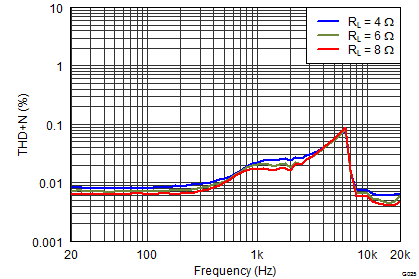
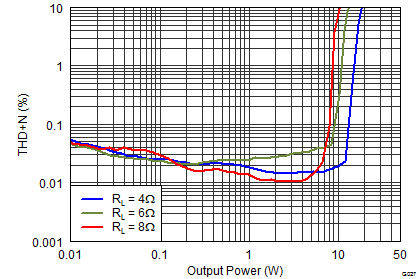
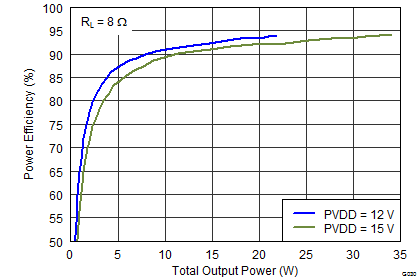 Figure 7. Efficiency vs Output Power
Figure 7. Efficiency vs Output Power
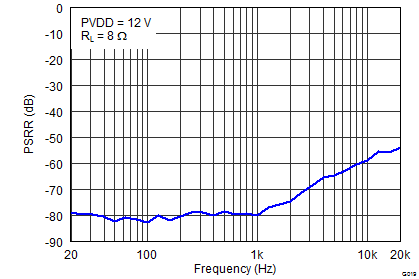 Figure 9. PVDD PSRR vs Frequency
Figure 9. PVDD PSRR vs Frequency
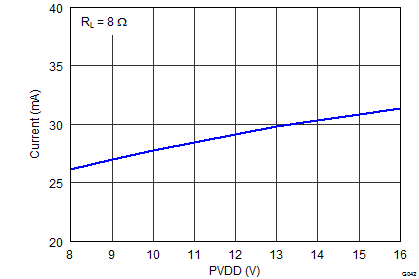 Figure 11. Idle Current Draw vs PVDD (Filterless)
Figure 11. Idle Current Draw vs PVDD (Filterless)
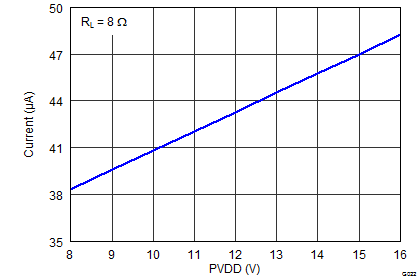 Figure 13. Shutdown Current Draw vs PVDD (Filterless)
Figure 13. Shutdown Current Draw vs PVDD (Filterless)
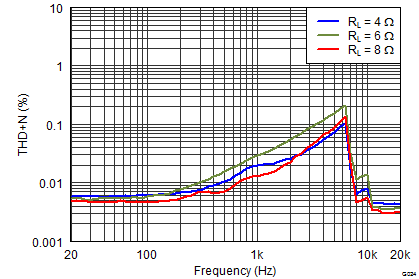
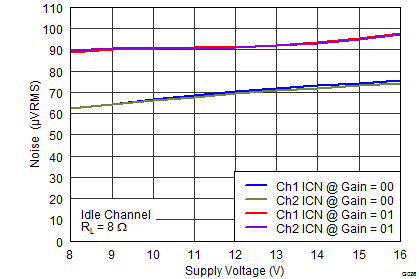 Figure 4. Idle Channel Noise vs PVDD
Figure 4. Idle Channel Noise vs PVDD
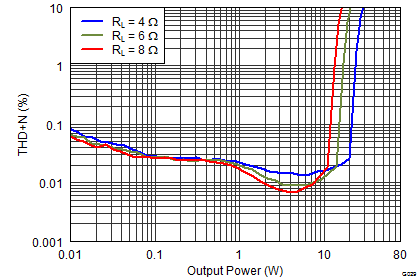
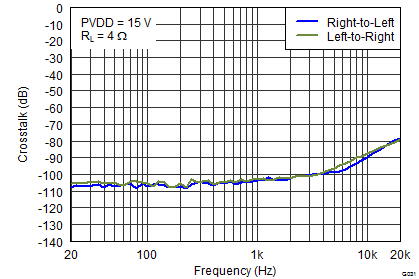 Figure 8. Crosstalk vs Frequency
Figure 8. Crosstalk vs Frequency
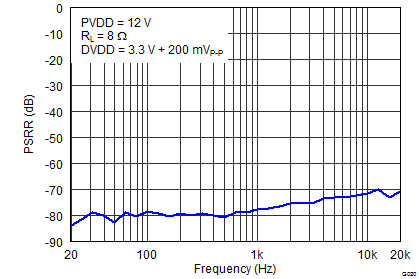 Figure 10. DVDD PSRR vs Frequency
Figure 10. DVDD PSRR vs Frequency
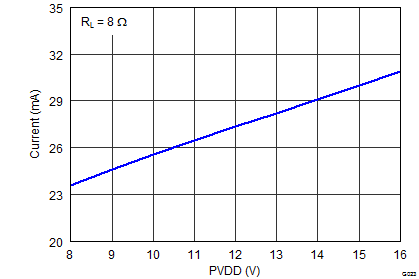
Filter used for 8 Ω = 22 µH + 0.68 µF, Filter used for 6 Ω = 15 µH + 0.68 µF, Filter used for 4 Ω = 10 µH + 0.68 µF unless otherwise noted.
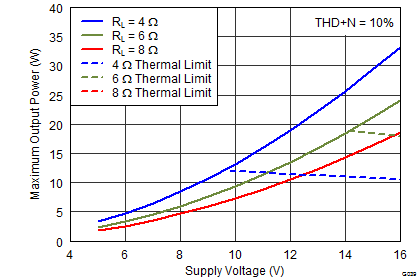
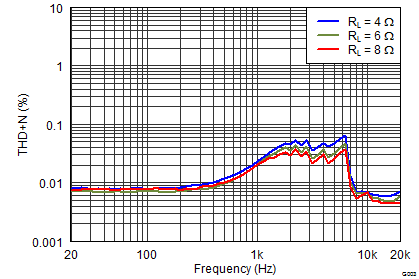
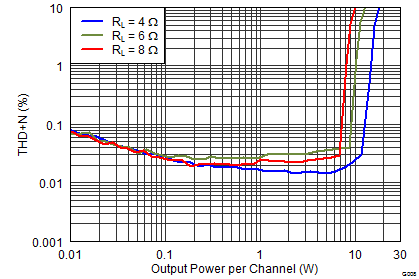
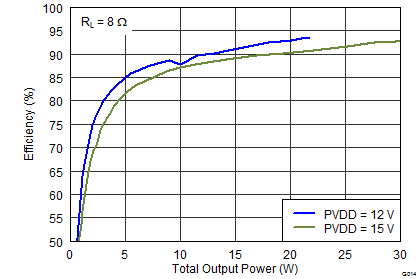 Figure 20. Efficiency vs Output Power
Figure 20. Efficiency vs Output Power
 Figure 22. PVDD PSRR vs Frequency
Figure 22. PVDD PSRR vs Frequency
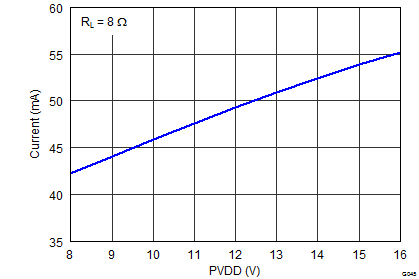 Figure 24. Idle Current Draw vs PVDD (with LC Filter as shown on EVM)
Figure 24. Idle Current Draw vs PVDD (with LC Filter as shown on EVM)
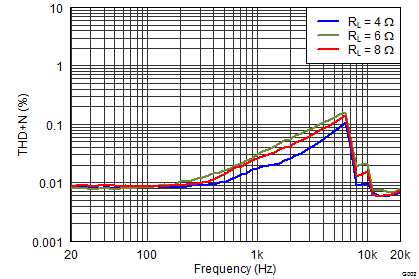
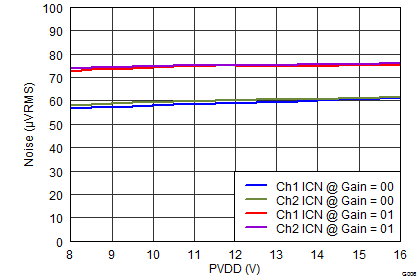 Figure 17. Idle Channel Noise vs PVDD
Figure 17. Idle Channel Noise vs PVDD
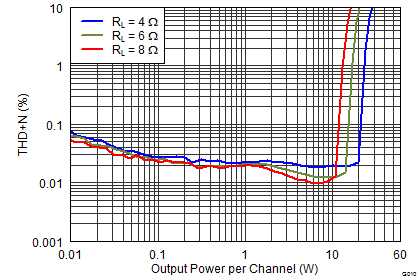
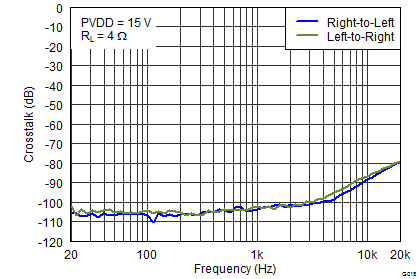 Figure 21. Crosstalk vs Frequency
Figure 21. Crosstalk vs Frequency
 Figure 23. Idle Current Draw vs PVDD (Filterless)
Figure 23. Idle Current Draw vs PVDD (Filterless)
 Figure 25. Shutdown Current Draw vs PVDD (Filterless)
Figure 25. Shutdown Current Draw vs PVDD (Filterless)
6.16 Typical Performance Characteristics (Mono PBTL Mode)
At TA = 25°C, fSPK_AMP = 384 kHz, input signal is 1 kHz Sine unless otherwise noted.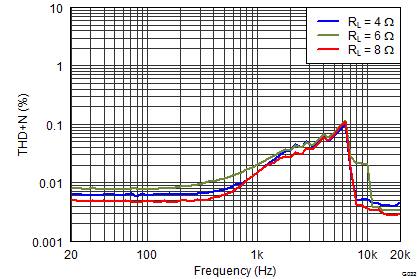
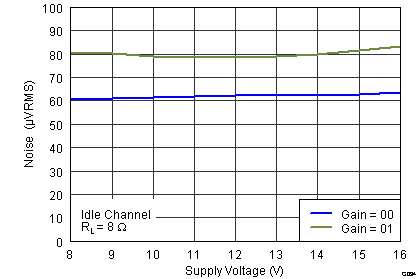 Figure 28. Idle Channel Noise vs PVDD
Figure 28. Idle Channel Noise vs PVDD
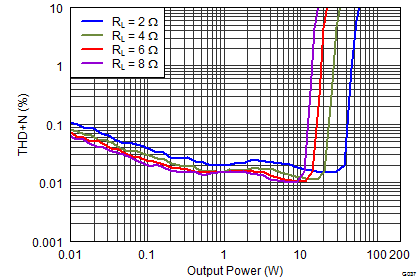
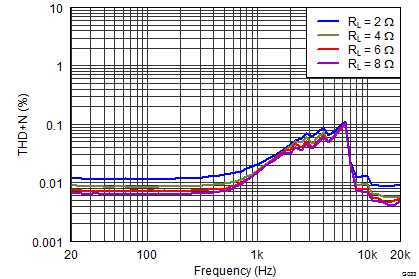
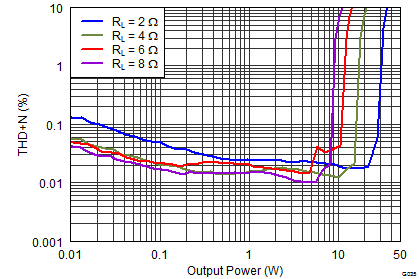
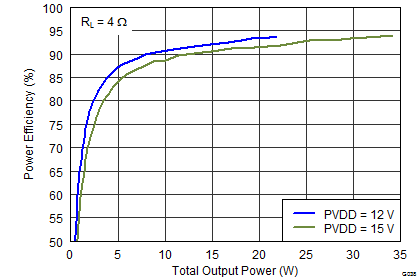 Figure 31. Efficiency vs Output Power
Figure 31. Efficiency vs Output Power
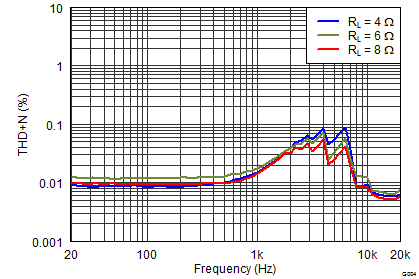
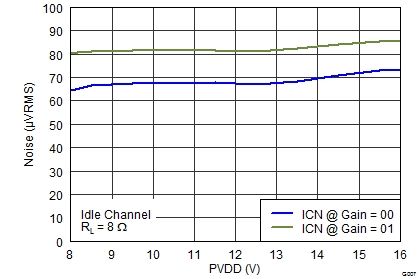 Figure 34. Idle Channel Noise vs PVDD
Figure 34. Idle Channel Noise vs PVDD
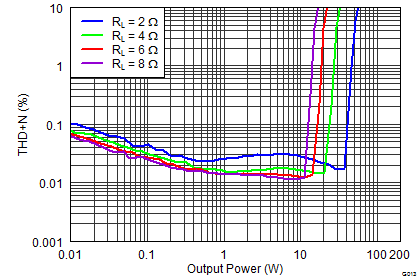 Figure 36. THD+N vs Output Power with PVDD = 12 V
Figure 36. THD+N vs Output Power with PVDD = 12 V
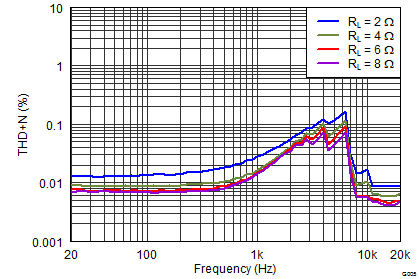
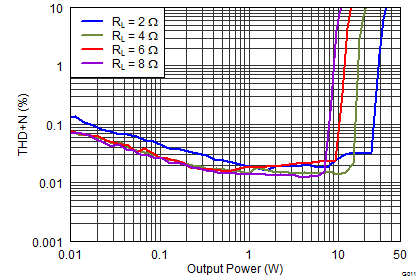 Figure 35. THD+N vs Output Power with PVDD = 12 V
Figure 35. THD+N vs Output Power with PVDD = 12 V
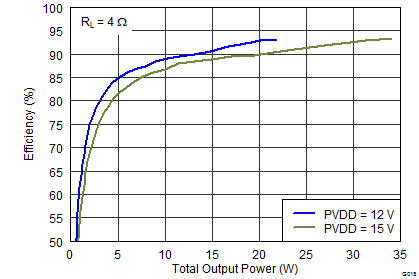 Figure 37. Efficiency vs Output Power
Figure 37. Efficiency vs Output Power